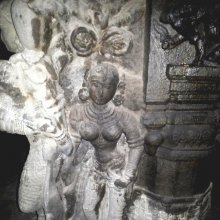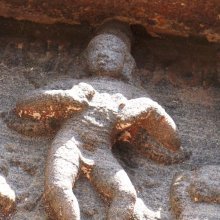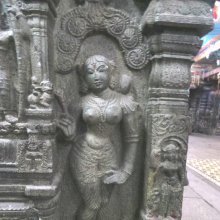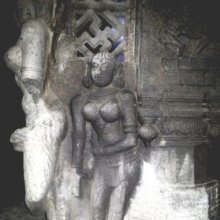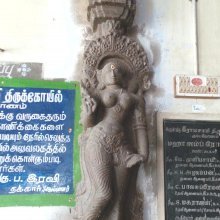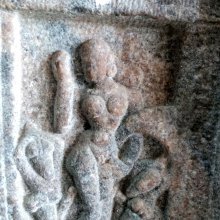Chinna, Chinnā: 28 definitions
Introduction:
Chinna means something in Buddhism, Pali, Hinduism, Sanskrit, the history of ancient India, Marathi, Jainism, Prakrit, Hindi, biology. If you want to know the exact meaning, history, etymology or English translation of this term then check out the descriptions on this page. Add your comment or reference to a book if you want to contribute to this summary article.
Alternative spellings of this word include Chhinna.
Ambiguity: Although Chinna has separate glossary definitions below, it also represents an alternative spelling of the word Ciṇṇa.
Images (photo gallery)
(+7 more images available)
In Hinduism
Natyashastra (theatrics and dramaturgy)
Source: Wisdom Library: Nāṭya-śāstra1) Chinna (छिन्न).—One of the 108 karaṇas (minor dance movement) mentioned in the Nāṭyaśāstra chapter 4. The instructions for this chinna-karaṇa is as follows, “the Alapadma hand to be held on the hip which in Chinna pose, the body in the Vaiśākha Sthāna (posture).”. A karaṇa represents a minor dance movements and combines sthāna (standing position), cārī (foot and leg movement) and nṛttahasta (hands in dancing position).
2) Chinna (छिन्न, “interrupted”) refers to a specific gesture (āṅgika) made with the chin (cibuka), according to the Nāṭyaśāstra chapter 8. These gestures form a part of the histrionic representation (abhinaya).
(Instructions of Chinna): when (the two lips) very closely meet each other. Uses: in sickness, fear, cold, (taking) exercise, and angry look.
3) Chinnā (छिन्ना, “turned aside”) refers to a specific ‘movement of the waist’ (kaṭi), according to the Nāṭyaśāstra chapter 10. The waist is one of the six major limbs (aṅga) used to perform certain gestures (āṅgika). These gestures form a part of the histrionic representation (abhinaya).
(Instructions of Chinnā): In turning the middle of the waist. Uses: in exercising [the limbs], hurry and looking round.
4) Chinna (छिन्न) refers to one of the twenty prakāras: rules used in the playing of drums (puṣkara) [with reference to Mṛdaṅga, Paṇava and Dardura] according to the Nāṭyaśāstra chapter 33. Accordingly, “the playing of drums in a quick tempo suddenly stopping when all other instruments are separately played, is called Chinna”.
Source: Shodhganga: Elements of Art and Architecture in the Trtiyakhanda of the Visnudharmottarapurana (natya)Chinna (छिन्न) refers to one of the 108 kinds of Karaṇa (“coordination of precise movements of legs and hands”), according to the Viṣṇudharmottarapurāṇa, an ancient Sanskrit text which (being encyclopedic in nature) deals with a variety of cultural topics such as arts, architecture, music, grammar and astronomy.—According to the Viṣṇudharmottarapurāṇa, karaṇas are the coordination of precise movements of legs and hands performed in a particular posture. The Nāṭyaśāstra also gives its view point in the same spirit. In the Viṣṇudharmottarapurāṇa, one hundred and eight kinds of karaṇas are accepted, e.g., Chinna.

Natyashastra (नाट्यशास्त्र, nāṭyaśāstra) refers to both the ancient Indian tradition (shastra) of performing arts, (natya—theatrics, drama, dance, music), as well as the name of a Sanskrit work dealing with these subjects. It also teaches the rules for composing Dramatic plays (nataka), construction and performance of Theater, and Poetic works (kavya).
Ayurveda (science of life)
Nighantu (Synonyms and Characteristics of Drugs and technical terms)
Source: WorldCat: Rāj nighaṇṭu1) Chinnā (छिन्ना) is another name for Guḍūcī, a medicinal plant identified with Tinospora cordifolia (heart-leaved moonseed) from the Menispermaceae or “moonseed family” of flowering plants, according to verse 3.13-16 of the 13th-century Raj Nighantu or Rājanighaṇṭu. The third chapter (guḍūcyādi-varga) of this book contains climbers and creepers (vīrudh). Together with the names Chinnā and Guḍūcī, there are a total of thirty Sanskrit synonyms identified for this plant.
2) Chinnā (छिन्ना) is also mentioned as a synonym for Mahāśrāvaṇī, an unidentified medicinal plant, according to verse 5.19-21. The fifth chapter (parpaṭādi-varga) of this book enumerates sixty varieties of smaller plants (kṣudra-kṣupa). Together with the names Chinnā and Mahāśrāvaṇī, there are a total of eight Sanskrit synonyms identified for this plant.

Āyurveda (आयुर्वेद, ayurveda) is a branch of Indian science dealing with medicine, herbalism, taxology, anatomy, surgery, alchemy and related topics. Traditional practice of Āyurveda in ancient India dates back to at least the first millenium BC. Literature is commonly written in Sanskrit using various poetic metres.
Shaktism (Shakta philosophy)
Source: Wisdom Library: ŚāktismChinna (छिन्न, “dispersed”) refers to one of the sixty defects of mantras, according to the 11th century Kulārṇava-tantra: an important scripture of the Kaula school of Śāktism traditionally stated to have consisted of 125.000 Sanskrit verses.—Accordingly, as Īśvara says to Śrī Devī: “For those who do japa without knowing these defects [e.g., chinna—dispersed], there is no realization even with millions and billions of japa. [...] Oh My Beloved! there are ten processes for eradicating defects in Mantras as described. [...]”.
Source: Google Books: ManthanabhairavatantramChinna (छिन्न) refers to “cutting (the roots of a tree)”, according to the Kubjikāmata-tantra, the earliest popular and most authoritative Tantra of the Kubjikā cult.—Accordingly, “O beloved, how can a disciple achieve liberation if the teacher he has found is powerless? How can a tree whose roots have been cut (mūla-chinna) bear flowers, fruit or (anything) else? Anyone who has found a teacher like this is released from bondage. The disciple who has seen him should worship the teacher with all his feeling. [...]”.

Shakta (शाक्त, śākta) or Shaktism (śāktism) represents a tradition of Hinduism where the Goddess (Devi) is revered and worshipped. Shakta literature includes a range of scriptures, including various Agamas and Tantras, although its roots may be traced back to the Vedas.
Purana and Itihasa (epic history)
Source: archive.org: Shiva Purana - English TranslationChinna (छिन्न) refers to “chopping off (all the legs of Dharma)”, according to the Śivapurāṇa 2.3.35 (“The story of Padmā and Pippalāda”).—Accordingly, as Padmā (wife of sage Pippalāda) said to Dharma: “[...] In the Tretāyuga, one leg shall be defunct, O excellent god. Another leg too shall be defunct in Dvāpara and the third one in the Kali age, O lord. In the latter half of Kali, all the legs will be chopped off (chinna). Again in the Satyayuga you will attain perfection. [...]”.

The Purana (पुराण, purāṇas) refers to Sanskrit literature preserving ancient India’s vast cultural history, including historical legends, religious ceremonies, various arts and sciences. The eighteen mahapuranas total over 400,000 shlokas (metrical couplets) and date to at least several centuries BCE.
Mantrashastra (the science of Mantras)
Source: Wisdom Library: MantrashastraChinna (छिन्न) refers to one of the various mantradoṣa (“defects of mantras”), according to Tantric digests such as the Bṛhattantrasāra (part 4 page 814), Nāradapurāṇa (Nārada-mahā-purāṇa) (verses 64.14-58), Śaradātilaka (verses 2.71-108), Padārthādarśa and Śrīvidyārṇava-tantra.—Chinna is defined as “at the beginning, in the middle, or at the end is the seed mantra of the air, vāyubīja yaṃ”. [unverified translation!] The Mantra defect elimination methods consist in performing purification rites (saṃskāra).—See Kulārṇava-tantra verse 15.71-2 and Śaradātilaka verse 2.114-22.
Mantrashastra (शिल्पशास्त्र, mantraśāstra) refers to the ancient Indian science of mantras—chants, incantations, spells, magical hymns, etc. Mantra Sastra literature includes many ancient books dealing with the methods reciting mantras, identifying and purifying its defects and the science behind uttering or chanting syllables.
Sports, Arts and Entertainment (wordly enjoyments)
Source: archive.org: Syainika Sastra of Rudradeva with English Translation (art)Chinna (छिन्न) refers to the “clipped (wings)” (of a mountain), according to the Śyainika-śāstra: a Sanskrit treatise dealing with the divisions and benefits of Hunting and Hawking, written by Rājā Rudradeva (or Candradeva) in possibly the 13th century.—Accordingly, [while discussing the outlines of hawking]: “[...] When a Vaharī is thrown at a Stork or a Heron from a great distance, it produces a feeling of wonder. What can be more wonderful than the fall of the quarry from the sky like a mountain with clipped wings (chinna-pakṣa) and frightened by the sound of swift motion?”.

This section covers the skills and profiencies of the Kalas (“performing arts”) and Shastras (“sciences”) involving ancient Indian traditions of sports, games, arts, entertainment, love-making and other means of wordly enjoyments. Traditionally these topics were dealt with in Sanskrit treatises explaing the philosophy and the justification of enjoying the pleasures of the senses.
In Buddhism
Mahayana (major branch of Buddhism)
Source: academia.edu: A Study and Translation of the GaganagañjaparipṛcchāChinna (छिन्न) or Saṃchinna refers to “(having) sliced off”, according to the Gaganagañjaparipṛcchā: the eighth chapter of the Mahāsaṃnipāta (a collection of Mahāyāna Buddhist Sūtras).—Accordingly, “[...] At that time, sixty koṭis of Bodhisattvas, having stood up from the congregation, joined their palms, paid homage to the Lord, and then uttered these verses in one voice: ‘[...] (227) Just as a mirror would never bring pleasure to those who had their noses and ears sliced off (saṃchinna-karṇanāsa), so, having heard the true accusation, they will reject the true dharma. (228) There will be monks who receive the true dharma and behave accordingly, but no one will listen to their dharmas. [...]’”.

Mahayana (महायान, mahāyāna) is a major branch of Buddhism focusing on the path of a Bodhisattva (spiritual aspirants/ enlightened beings). Extant literature is vast and primarely composed in the Sanskrit language. There are many sūtras of which some of the earliest are the various Prajñāpāramitā sūtras.
India history and geography
Source: Project Gutenberg: Castes and Tribes of Southern India, Volume 1Chinna (“gold”) or Sinnata is one of the exogamous septs (divisions) among the Kurubas (a tribe of South India). The Kurubas are sub-divided into clans or gumpus, each having a headman or guru called a gaudu, who gives his name to the clan. And the clans are again sub-divided into gotras or septs (viz., Chinna).
Source: Singhi Jain Series: Ratnaprabha-suri’s Kuvalayamala-katha (history)Chiṇṇa (छिण्ण) refers to a “clipped” (nose) and was commonly found in the city of Mathurā at some point in time in ancient India, according to Uddyotanasūri in his 8th-century Kuvalayamālā (a Prakrit Campū, similar to Kāvya poetry).—The Kuvalayamala (779 A.D.) is full of cultural material which gains in value because of the firm date of its composition. [...] On page 55.11 f., there is a description of poor home (aṇāha-maṇḍava) in the city of Mathurā. In its population there was a sprinkling of disabled persons: [e.g., Clipped or cut-nose (chiṇṇa-ṇāsaya)] [...]. The invaders of the orphan home exchange their views as to which sin may be washed at which holy place. [...]

The history of India traces the identification of countries, villages, towns and other regions of India, as well as mythology, zoology, royal dynasties, rulers, tribes, local festivities and traditions and regional languages. Ancient India enjoyed religious freedom and encourages the path of Dharma, a concept common to Buddhism, Hinduism, and Jainism.
Biology (plants and animals)
Source: Wisdom Library: Local Names of Plants and DrugsChinna in the Hindi language is the name of a plant identified with Sorghum halepense from the Poaceae (Grass) family having the following synonyms: Andropogon halepensis. For the possible medicinal usage of chinna, you can check this page for potential sources and references, although be aware that any some or none of the side-effects may not be mentioned here, wether they be harmful or beneficial to health.

This sections includes definitions from the five kingdoms of living things: Animals, Plants, Fungi, Protists and Monera. It will include both the official binomial nomenclature (scientific names usually in Latin) as well as regional spellings and variants.
Languages of India and abroad
Pali-English dictionary
Source: BuddhaSasana: Concise Pali-English Dictionarychinna : (pp. of chindati) cut; destroyed.
Source: Sutta: The Pali Text Society's Pali-English DictionaryChinna, (pp. of chindati) cut off, destroyed Vin.I, 71 (acchinna-kesa with unshaven hair); M.I, 430; D.II, 8 (°papañca); J.I, 255; II, 155; IV, 138; Dh.338; Pv.I, 112 (v. l. for bhinna), 116; DhA.IV, 48. Very often in punishments of decapitation (sīsa°) or mutilation (hatthapāda°, etc.) e.g. Vin.I, 91; III, 28; Pv.II, 24 (ghāna-sīsa°); Miln.5. Cp. sañ°. As first part of cpd., chinna° very frequently is to be rendered by “without, ” e. g.

Pali is the language of the Tipiṭaka, which is the sacred canon of Theravāda Buddhism and contains much of the Buddha’s speech. Closeley related to Sanskrit, both languages are used interchangeably between religions.
Marathi-English dictionary
Source: DDSA: The Molesworth Marathi and English Dictionarychinna (छिन्न).—n S In modern compositions. A squared surface, or a cut and made plane. 2 unc A rude or irregular chip or fragment.
--- OR ---
chinna (छिन्न).—p S Cut, split, severed, divided. chinnapuccha Having the tail cut; chinnahasta Having the hand cut off; chinnakarṇa Earcropt; chinnanāsika, chinnāvayava &c.
Source: DDSA: The Aryabhusan school dictionary, Marathi-Englishchinna (छिन्न).—p Cut, split, divided.
Marathi is an Indo-European language having over 70 million native speakers people in (predominantly) Maharashtra India. Marathi, like many other Indo-Aryan languages, evolved from early forms of Prakrit, which itself is a subset of Sanskrit, one of the most ancient languages of the world.
Sanskrit dictionary
Source: DDSA: The practical Sanskrit-English dictionaryChinna (छिन्न).—p. p. [chid-kta]
1) Cut, divided, rent, chopped, riven, torn, broken.
2) Destroyed, removed; see छिद् (chid)
3) Decaying, declining.
4) Exhausted, tired, fatigued.
-nnā A whore, harlot.
Source: Cologne Digital Sanskrit Dictionaries: Edgerton Buddhist Hybrid Sanskrit DictionaryChinna (छिन्न).—adj. (ppp.; not recorded in this sense), wearied; in strī-, bhāra-, mārga-chinna, Mahāvyutpatti 8793—5; Mūla-Sarvāstivāda-Vinaya iv.68.13—14; Tibetan dub pa.
Source: Cologne Digital Sanskrit Dictionaries: Shabda-Sagara Sanskrit-English DictionaryChinna (छिन्न).—mfn.
(-nnaḥ-nnā-nnaṃ) Cut, divided. f.
(-nnā) 1. A whore, a harlot. 2. A tree: see guḍūcī. E. chid to cut, affix kta, deriv. irr.
Source: Cologne Digital Sanskrit Dictionaries: Cappeller Sanskrit-English DictionaryChinna (छिन्न).—[adjective] cut off or in, carved, incoherent; included by (—°), broken, destroyed, vanished.
Source: Cologne Digital Sanskrit Dictionaries: Monier-Williams Sanskrit-English Dictionary1) Chinna (छिन्न):—[from chid] mfn. cut off, cut, divided, torn, cut through, perforated, [Atharva-veda] etc.
2) [v.s. ...] opened (a wound), [Suśruta]
3) [v.s. ...] interrupted, not contiguous, [Bhagavad-gītā vi, 36; Rāmāyaṇa iii, 50, 12; Varāha-mihira’s Bṛhat-saṃhitā]
4) [v.s. ...] disturbed (kiṃ naś chinnam, ‘what is there in this to disturb us?’ there is nothing to care about, [Amaru-śataka]), [Harivaṃśa 16258; Mṛcchakaṭikā]
5) [v.s. ...] ? (said of the belly of a leach), [Suśruta]
6) [v.s. ...] limited by (in [compound]), [Bhartṛhari iii, 20]
7) [v.s. ...] taken away or out of [Rāmāyaṇa ii, 56, 23; Raghuvaṃśa xii, 80]
8) [v.s. ...] disappeared, [Kathāsaritsāgara lxi, 47]
9) [v.s. ...] ifc. decaying or exhausted by, [Buddhist literature; cf. Lexicographers, esp. such as amarasiṃha, halāyudha, hemacandra, etc.]
10) Chinnā (छिन्ना):—[from chinna > chid] f. a harlot, [cf. Lexicographers, esp. such as amarasiṃha, halāyudha, hemacandra, etc.]
11) [v.s. ...] = nnodbhavā, [Bhāvaprakāśa v, 3, 6] (cf. a-, reṣma-).
Source: Cologne Digital Sanskrit Dictionaries: Yates Sanskrit-English DictionaryChinna (छिन्न):—[(nnaḥ-nnā-nnaṃ) a.] Cut. f. A whore.
Source: DDSA: Paia-sadda-mahannavo; a comprehensive Prakrit Hindi dictionary (S)Chinna (छिन्न) in the Sanskrit language is related to the Prakrit words: Chinna, Ṇicchallia, Ṇillūriya, Ṇivvaria, Duhāvia, Lūria.
[Sanskrit to German]
Sanskrit, also spelled संस्कृतम् (saṃskṛtam), is an ancient language of India commonly seen as the grandmother of the Indo-European language family (even English!). Closely allied with Prakrit and Pali, Sanskrit is more exhaustive in both grammar and terms and has the most extensive collection of literature in the world, greatly surpassing its sister-languages Greek and Latin.
Hindi dictionary
Source: DDSA: A practical Hindi-English dictionaryChinna (छिन्न) [Also spelled chhinn]:—(a) incised; rent; cut off; chopped off; -[bhinna] cut; broken; scattered, shattered; ~[mūla] cut up from the root, uprooted.
...
Prakrit-English dictionary
Source: DDSA: Paia-sadda-mahannavo; a comprehensive Prakrit Hindi dictionaryChinna (छिन्न) in the Prakrit language is related to the Sanskrit word: Chinna.
Prakrit is an ancient language closely associated with both Pali and Sanskrit. Jain literature is often composed in this language or sub-dialects, such as the Agamas and their commentaries which are written in Ardhamagadhi and Maharashtri Prakrit. The earliest extant texts can be dated to as early as the 4th century BCE although core portions might be older.
Kannada-English dictionary
Source: Alar: Kannada-English corpusChinna (ಛಿನ್ನ):—
1) [adjective] rendered into pieces; broken; shattered; smashed.
2) [adjective] spoiled; destroyed.
--- OR ---
Chinna (ಛಿನ್ನ):—
1) [noun] a kind of lung-disease.
2) [noun] (dance.) a positioning of oneself in a standing pose by keeping the hands on the waist in a particular mode.
3) [noun] (dance.) a pressing of both the rows of the teeth on each other.
Kannada is a Dravidian language (as opposed to the Indo-European language family) mainly spoken in the southwestern region of India.
See also (Relevant definitions)
Starts with (+148): Chinna Babu Samudram, Chinna kalinga, Chinna karai pullu, Chinna karai pully, Chinna karinga, Chinna korai pul, Chinna moralli, Chinna mutavapulagamu, Chinna nidra kanti, Chinna puliarai, Chinna ranabheri, Chinna sundai, Chinna-botuku, Chinna-buddabusara, Chinna-kalinga, Chinna-kurinji, Chinna-melam, Chinna-nakkera-chettu, Chinna-nakkeru, Chinna-neredu.
Ends with (+51): Abbhocchinna, Abbocchinna, Acchinna, Achinna, Akkhachinna, Anavacchinna, Anukchinna, Anupacchinna, Aparicchinna, Apracchinna, Avacchinna, Avicchinna, Avocchinna, Avvocchinna, Avyavacchinna, Avyucchinna, Bahichinna, Bahucchinna, Bahuchinna, Cakkachinna.
Full-text (+147): Chinnakesha, Chinnakarna, Chinnamasta, Chinnasamshaya, Chinnaveshika, Chinnaruha, Chinnabandhana, Acchinna, Duhavia, Chinnavat, Chinnabhinna, Chinnanasya, Chinnagranthinika, Chinnapattri, Chinnadruma, Granthinika, Chinnapaksha, Chinnodbhava, Chinnamastaka, Chinnaka.
Relevant text
Search found 30 books and stories containing Chinna, Chinnā, Chiṇṇa; (plurals include: Chinnas, Chinnās, Chiṇṇas). You can also click to the full overview containing English textual excerpts. Below are direct links for the most relevant articles:
Garga Samhita (English) (by Danavir Goswami)
Verses 1.10.18-19 < [Chapter 10 - Description of the Birth of Lord Balarāma]
Verse 4.14.12 < [Chapter 14 - The Story of the Jālandharīs]
Verse 2.5.15 < [Chapter 5 - The Liberation of Bakāsura]
Amaravati Art in the Context of Andhra Archaeology (by Sreyashi Ray chowdhuri)
Lower Kṛṣṇā Valley (27): Chinna Ganjam < [Chapter 2 - Amarāvatī and other Archaeological Sites of Ancient Andhra Pradesh]
Natyashastra (English) (by Bharata-muni)
Chapter X - Gestures of other Limbs
Chapter IV - Description of the Class Dance (tāṇḍava)
The Mahavastu (great story) (by J. J. Jones)
Chapter II-b - The hell named Saṃjīva < [Volume I]
Chapter VIII - The conversion of Śāriputra and Maudgalyāyana < [Volume III]
Chapter XXXI - The final defeat of Māra < [Volume II]
Shrimad Bhagavad-gita (by Narayana Gosvami)
Verse 5.25 < [Chapter 5 - Karma-sannyāsa-yoga (Yoga through Renunciation of Action)]
Verse 18.10 < [Chapter 18 - Mokṣa-yoga (the Yoga of Liberation)]
Verse 6.38 < [Chapter 6 - Dhyāna-yoga (Yoga through the Path of Meditation)]
Sahitya-kaumudi by Baladeva Vidyabhushana (by Gaurapada Dāsa)
Text 10.152 < [Chapter 10 - Ornaments of Meaning]
